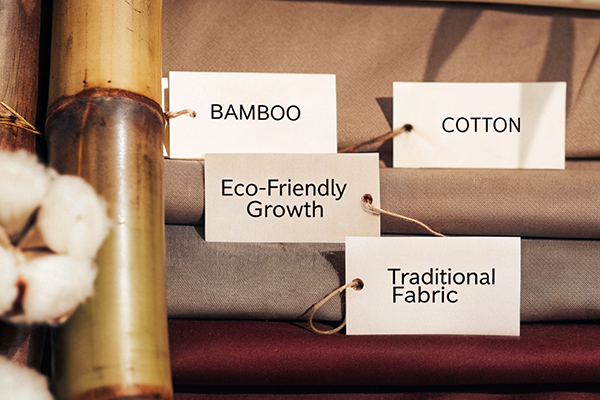Bamboo and cotton are two of the most popular fabrics in clothing, each offering unique benefits. While cotton has been a staple for centuries, bamboo fabric has gained popularity as a modern, eco-friendly alternative. But how do they compare in terms of comfort, skin-friendliness, and sustainability?
Bamboo fabric is often touted for its softness, breathability, and hypoallergenic qualities, while cotton remains a trusted choice for its durability and versatility.
Let’s explore whether bamboo is as good as cotton for clothes and if it’s better for your skin.
Is bamboo better for skin than cotton?
One of the most important considerations when choosing clothing is how it feels against your skin.
Bamboo is often better for sensitive skin than cotton due to its hypoallergenic properties, moisture-wicking abilities, and ultra-soft texture.

Why Bamboo is Skin-Friendly
-
Hypoallergenic Properties
Bamboo fabric is naturally gentle on the skin1, making it ideal for those with allergies or sensitivities.
- It resists dust mites and doesn’t require harsh chemicals during processing.
-
Moisture-Wicking and Breathability
Bamboo fibers wick moisture away from the skin, keeping you cool and dry. This feature reduces the risk of irritation caused by sweat.
-
Silky Softness
Bamboo fabric is softer than many types of cotton, giving it a luxurious feel that’s perfect for delicate skin.
Cotton’s Skin Benefits
-
Breathable and Soft
Cotton is naturally breathable, allowing air to flow freely and preventing heat buildup. It’s also soft, although some varieties like organic or combed cotton are gentler than standard options.
-
Less Processed Options
Organic cotton2 offers a skin-safe alternative, free from synthetic chemicals or dyes.
| Fabric | Skin Benefits |
|---|---|
| Bamboo | Hypoallergenic, moisture-wicking, ultra-soft |
| Cotton | Breathable, soft, suitable for all skin types |
For people with sensitive or easily irritated skin, bamboo fabric often comes out ahead due to its gentle and moisture-wicking qualities.
Comparing Bamboo and Cotton for Everyday Wear
Bamboo and cotton both excel in comfort and practicality, but their performance in specific scenarios differs.

Comfort and Feel
-
Bamboo: Feels silky and smooth, often compared to cashmere or silk.
-
Cotton: Soft and cozy, with a familiar texture that varies based on the weave (e.g., jersey, flannel).
Moisture Management
-
Bamboo: Naturally wicks sweat and prevents odor, making it ideal for humid conditions or activewear.
-
Cotton: Absorbs moisture but doesn’t wick it away as effectively, which can lead to a damp feeling.
Temperature Regulation
-
Bamboo: Insulates well in cooler weather while remaining breathable in the heat.
-
Cotton: Breathable and lightweight, though less adaptable to temperature changes.
| Attribute | Bamboo | Cotton |
|---|---|---|
| Softness | Ultra-soft, silky | Soft, varies by type |
| Moisture Control | Excellent moisture-wicking | Absorbs moisture |
| Temperature Regulation | Good for all seasons | Breathable, better for warm weather |
Bamboo often feels more luxurious and performs better in moisture control, while cotton remains a reliable, versatile choice.
How Sustainable is Bamboo Compared to Cotton?
Environmental impact is a growing concern when choosing fabrics. Bamboo is often marketed as an eco-friendly option, but how does it compare to cotton?

Bamboo’s Sustainability
-
Fast Growth
Bamboo grows quickly, requiring minimal water, pesticides, or fertilizers. This makes it a renewable resource.
-
Biodegradability
Bamboo fabric decomposes naturally, reducing waste compared to synthetic fabrics.
-
Processing Concerns
-
While raw bamboo is sustainable, the process of turning it into fabric3 (often using chemicals to create viscose) can be less eco-friendly.
-
Look for lyocell bamboo4, which uses a closed-loop process to minimize chemical waste.
-
Cotton’s Sustainability
-
High Water Usage
Conventional cotton requires large amounts of water to grow, making it less eco-friendly in arid regions.
-
Pesticide Use
Cotton farming often involves pesticides and fertilizers, which can harm ecosystems.
- Organic cotton2 is a more sustainable option, grown without harmful chemicals.
-
Recyclability
Cotton is biodegradable and can be recycled into new products, reducing its environmental footprint.
| Sustainability Factor | Bamboo | Cotton |
|---|---|---|
| Water Use | Low | High |
| Pesticides | Minimal | Conventional cotton uses many |
| Processing Impact | Depends on production method | Organic options available |
Bamboo’s rapid growth and lower resource needs give it an edge in sustainability, but organic cotton provides a strong, eco-friendly alternative.
Durability and Longevity
How long a fabric lasts plays a big role in its overall value and sustainability.
Bamboo Durability
-
Bamboo fabric is strong and resistant to pilling when properly cared for.
-
It retains its softness over time, even after repeated washes.
Cotton Durability
-
Cotton is durable, especially when tightly woven (e.g., denim or canvas).
-
Over time, cotton may fade or shrink if not cared for properly, but high-quality cotton like Egyptian or Pima lasts longer.
Care Tips for Each Fabric
-
Bamboo: Wash in cold water and avoid high heat5 to maintain softness.
-
Cotton: Use mild detergents and avoid over-drying to prevent shrinkage.
| Attribute | Bamboo | Cotton |
|---|---|---|
| Strength | Resistant to pilling | Stronger in tightly woven forms |
| Care Requirements | Gentle washing recommended | Standard care is sufficient |
Both fabrics are durable when treated well, but bamboo’s softness makes it more sensitive to heat and harsh detergents.
Use Cases: Bamboo vs. Cotton
Your lifestyle and needs can determine whether bamboo or cotton is the better choice for specific types of clothing.

Best Uses for Bamboo Fabric
-
Activewear
Bamboo’s moisture-wicking and odor-resistant properties make it ideal for workout gear.
-
Sleepwear
Its silky texture and temperature regulation provide ultimate comfort for pajamas.
-
Underwear
Hypoallergenic and breathable, bamboo is perfect for sensitive areas.
Best Uses for Cotton Fabric
-
Casual Wear
Cotton’s versatility makes it great for t-shirts, jeans, and everyday apparel.
-
Workwear
Durable cotton fabrics like denim and canvas are perfect for labor-intensive jobs.
-
Children’s Clothing
Cotton’s softness and natural feel are safe for babies and kids.
| Clothing Type | Bamboo | Cotton |
|---|---|---|
| Activewear | Moisture-wicking, odor-resistant | Less effective for sweat |
| Casual Wear | Soft and breathable | Durable and versatile |
| Sleepwear | Luxuriously soft and cool | Lightweight and comfortable |
By matching the fabric to the intended use, you can get the most out of both bamboo and cotton.
Conclusion
Bamboo and cotton each have their strengths, making them suitable for different purposes. Bamboo is ultra-soft, hypoallergenic, and excels in moisture management, making it great for activewear, underwear, and sleepwear. Cotton, on the other hand, is versatile, durable, and reliable for casual and workwear. When choosing between the two, consider your skin sensitivity, lifestyle needs, and environmental priorities. Both fabrics have a place in a well-rounded wardrobe, so why not enjoy the best of both worlds?













